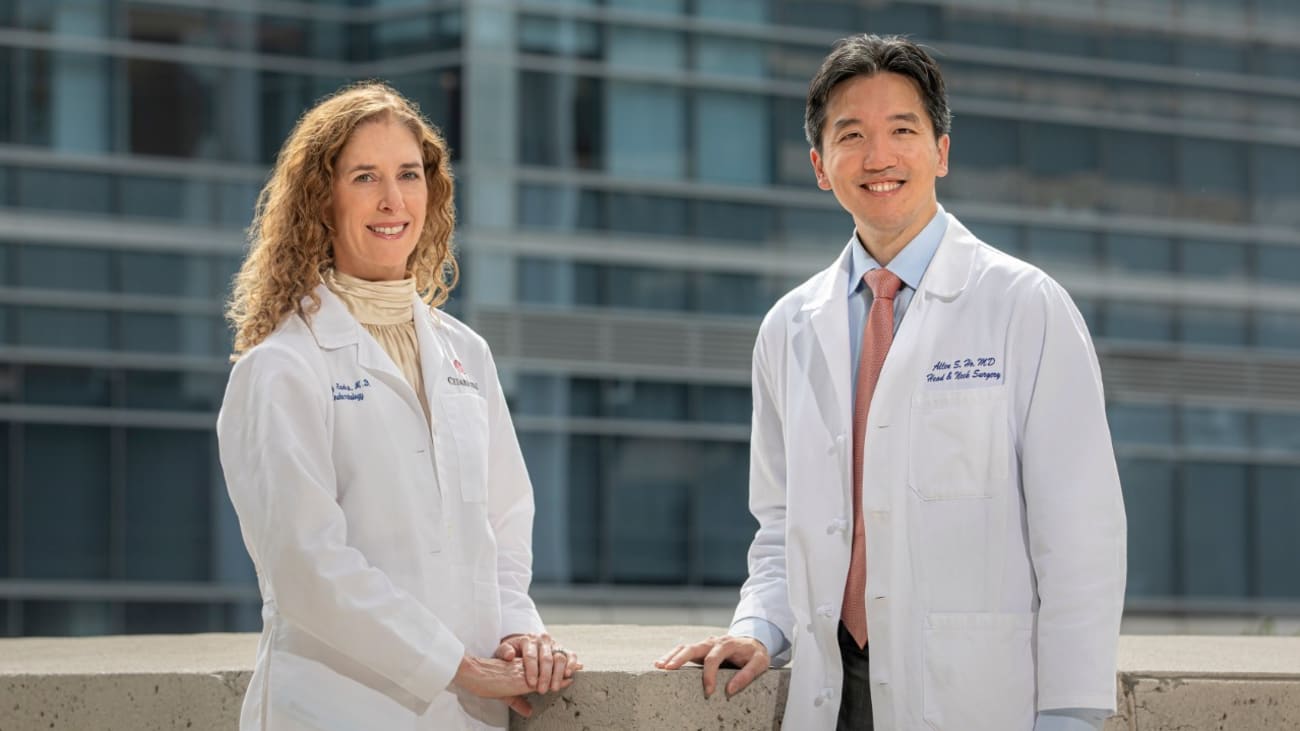

Research Published in JAMA Oncology Determines Many Low-Risk Thyroid Cancers Can Be as Effectively Managed With Monitoring as With Surgery
A novel clinical trial from Cedars-Sinai Cancer shows that active surveillance is an effective treatment for many low-risk thyroid cancer patients. The study, published in JAMA Oncology, also showed for the first time that patients who opted for active surveillance experienced less anxiety than patients who underwent surgery.
The findings swing the pendulum toward a less-invasive approach to treating thyroid cancer, says Allen Ho, MD, lead author of the study and co-director of the Thyroid Cancer Program at Cedars-Sinai Cancer.

Active surveillance is just that—actively surveying, or monitoring—a patient’s condition or disease with close imaging follow-up. If the cancer grows, physicians can still safely intervene with surgery.
“The vast majority of thyroid cancers spread infrequently and are almost never lethal yet are often treated aggressively with surgery and other treatment interventions,” Ho said. “Active surveillance—as it has been used so successfully in prostate cancer—is feasible for low-risk thyroid cancer, marking an important course change in how we treat the disease.”
While thyroid cancer diagnoses have escalated in recent decades, most are slow growing, lack symptoms and have survival rates of almost 100%. As such, efforts to curb this rise in incidence have led to guideline shifts in screening, diagnosis and staging.
“Nonetheless, oncologists and surgeons often struggle to reframe a condition that is low risk, yet brings tremendous emotional burden and anxiety from the label of cancer,” said Ho.
The seven-year prospective clinical trial led by Cedars-Sinai Cancer aimed to not only evaluate how beneficial active surveillance is in treating the disease, but also to address patient anxiety associated with the diagnosis.
Of 222 patients enrolled in the study, 112 patients with tumors less than 20 millimeters in size underwent active surveillance and 110 opted for surgery.
“Throughout the seven years of the trial, none of the patients enrolled in active surveillance developed imaging evidence of disease metastasis, and just a small fraction—3.6%—experienced any sort of meaningful tumor growth,” said Wendy Sacks, MD, co-director of the Thyroid Cancer Program and senior author of the study. “Equally notable, all patients—including those who enrolled in active surveillance and those who opted for surgery—remained at stage 1 of their diagnosis and had 100% survival rates.”
To date, 90.1% of patients who enrolled in active surveillance remain on it, whereas 7.1% of patients eventually opted for surgery based on either personal preference or physician advice.
These findings, researchers said, shed light on the idea that the majority of patients with low-risk thyroid cancer who choose active surveillance can continue to undergo monitoring, knowing they may never need to undergo surgery.
“And, for the slim margin of patients who see growth of their tumor, we can safely remove it through surgery,” said Sacks.
The study also evaluated patient anxiety, comparing the level of worry for those who opted for active surveillance, versus those who opted for surgery.
Of the 222 patients enrolled in the clinical trial, 84 agreed to complete longitudinal anxiety surveys over time. Patients who underwent immediate surgery were found to have significantly higher anxiety scores than the patients who selected active surveillance.
“We were also surprised to find that the long-term higher anxiety scores for immediate surgery patients persisted despite intervention, while the lower anxiety scores encountered with the active surveillance group trended lower,” said Ho, also a professor of Surgery at Cedars-Sinai and director of the Head and Neck Cancer Program at Cedars-Sinai Cancer. “We now understand that active surveillance in some patients represents a durable option that is associated with less anxiety.”

Dan Theodorescu, MD, PhD
Study authors caution, however, that while active surveillance is appropriate for some patients, it is important that institutions designate either radiologists or endocrinologists familiar with interpreting thyroid and neck ultrasound to monitor these patients.
“At Cedars-Sinai Cancer, we aim to address not only the physical hardships of cancer, but also the mental and social wellbeing of every individual we treat,” said Dan Theodorescu, MD, PhD, director of Cedars-Sinai Cancer and the PHASE ONE Foundation Distinguished Chair and professor of Surgery and Pathology and Laboratory Medicine. “This clinical trial is a prime example of our commitment to do just this.”
Funding: This work was supported in part by the Cancer Clinical Trials Office of Cedars-Sinai Cancer.
Read more from the Cedars-Sinai Blog: Active Surveillance for Thyroid Cancer
